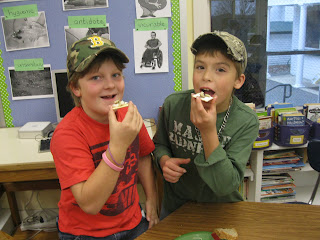I've never made a baked apple before this week.
Many of my posts could start that way. I've never made
ice cream in a bag before this week. I've never
baked bread in a cast iron pot before this week. I've never kept
sourdough starter before. I'm exposing myself to new foods and cooking ideas as much as I am exposing my students to them.
This week's surprises me because baked apples are SO easy and SO yummy. How is it that I've never made one before?
The inspiration:
1) My funds are
very limited this year, but I can get produce free through Emilyinthekitchen and our school's fresh fruits and veggies grant.
2) My class worked very hard on standardized testing this week and I felt like they deserved a celebratory cooking project.
Enter the apple. I would have loved to make
these instead, but I took a deep breath and reminded myself that Friday afternoon I was leaving school right away to go on a girls getaway weekend and I didn't want to be stuck in my classroom cleaning up a pie crust mess. Then I talked to Emily and she suggested I set up the apple stuffing like an ice cream bar. Here are the possible toppings; how would you like your apple? I got together raisins, craisins, cinnamon, nutmeg, cloves, ginger. Also oats, thinking a few kids might want to mash the toppings together and stuff an apple crisp type topping in the middle.
Thursday night while I heated up leftovers for dinner, I used a grapefruit spoon to scoop out most of the middle of an apple. I dropped in some raisins, brown sugar, a pat of butter, and put the apple in a pan with a half inch of water in the bottom. It sat in the oven for half an hour while my daughter and I ate dinner and we split it for dessert. It doesn't get any easier than that.
The glitch of the week is that amazing Su was hammered with a bad cold earlier in the week and emailed me Thursday night to say she wouldn't be coming to school on Friday. (Su, I hope you're on the mend!) I had been planning to have half the group prep their apples while the other half did a Check It Out circle to preview a stack of new class books we got through book order. This was in part due to the number of grapefruit spoons that people lent me. (Thanks Vera! Thanks Barb!) Everyone couldn't scoop at the same time.
No worries. We've shared materials before. Before I could revise my new plan, a parent contacted me and asked if she could come in for the afternoon. So I ended up with the amazing Roberta taking the cooking half of the group and I kids got to preview new books
and prep their apples all in a tidy thirty minute period. Linda came in to help with reading and took over the book group, so I even got to squeeze in some pictures.
 |
| The intersection of food and books was spectacular. |
Are you wondering how we kept track of whose apple was whose? Anyone that knows me knows that as much as I try to camouflage my Type A tendencies, they are still there, all the time. I made a map of the apples and labelled each one on the map as each student put them in the pan.
One student asked me what would happen if the pan got rotated to a different direction. I dredged up the term rotational symmetry and we agreed it was a good thing that there weren't twenty four kids in the class.
At 1:30 we had twenty two apples ready to go in the oven, a table covered in oat crumbles and twenty two wound up kids. Roberta turned to me and said, "Do you think they need to come play a few relay races in my yard?" (Did I mention? Roberta lives next door and our classroom windows look down on her yard. She even sent her daughter home to get more oats when we ran out!) Roberta took the class outside and the remaining adults wiped down tables and put the apples in the oven. Emily was still in the kitchen and took over the oven end of things for us. I went to go pick up the kids and found them running relay races carrying pumpkins from Roberta's garden!
Back inside to have a short conversation about leadership projects for the year, and then the apples were ready.
Emily brought them down and a student fetched the ice cream I had stashed in the freezer. A half gallon of ice cream split twenty two ways doesn't go far, but that was ok. The apples are yummy on their own and don't need a lot of sweetening up.
 |
| Not, perhaps, the most photogenic dessert. But tasty. |
"I didn't think I'd like these, but I do," one child commented.
"Can I take some of this home to let my dad try?" asked another.
"You can make this yourself for him," I responded. "Just go buy some apples."
Another student listened intently when I first told them about the recipe, then raised his hand to ask how long to bake the apples and at what temperature. He does a lot of cooking at home so who knows? He might have the oven on at home right now...
This was my point. It's easy to make delicious and healthy desserts. Sometimes, you don't even need a recipe.

















































